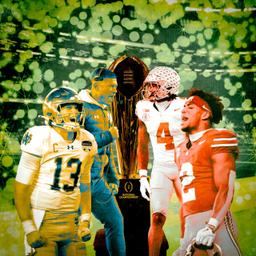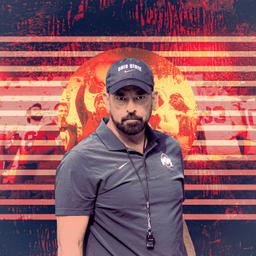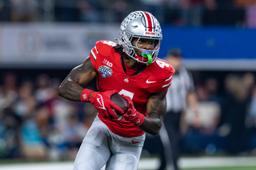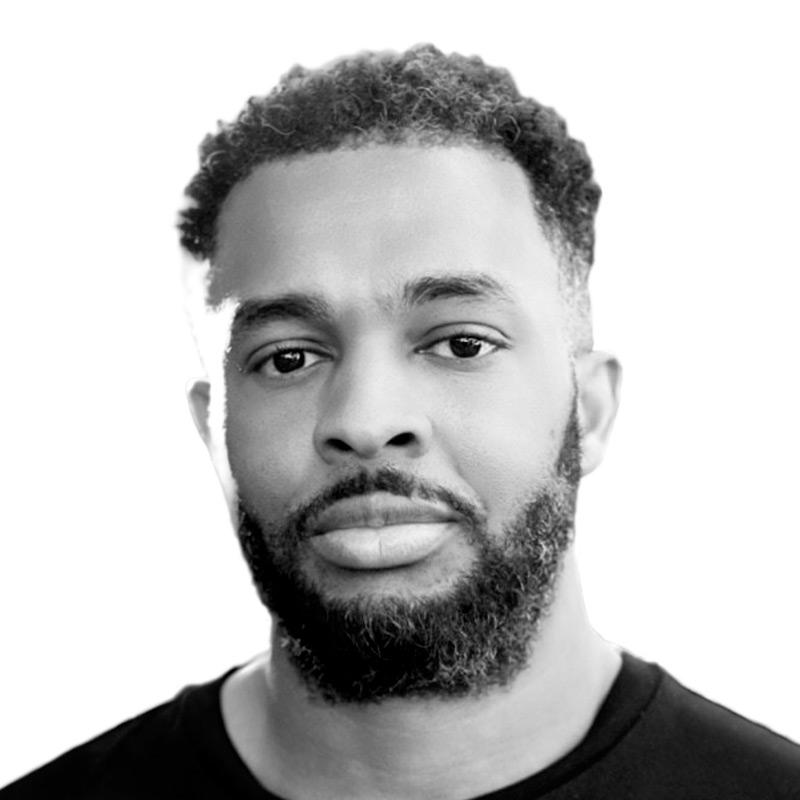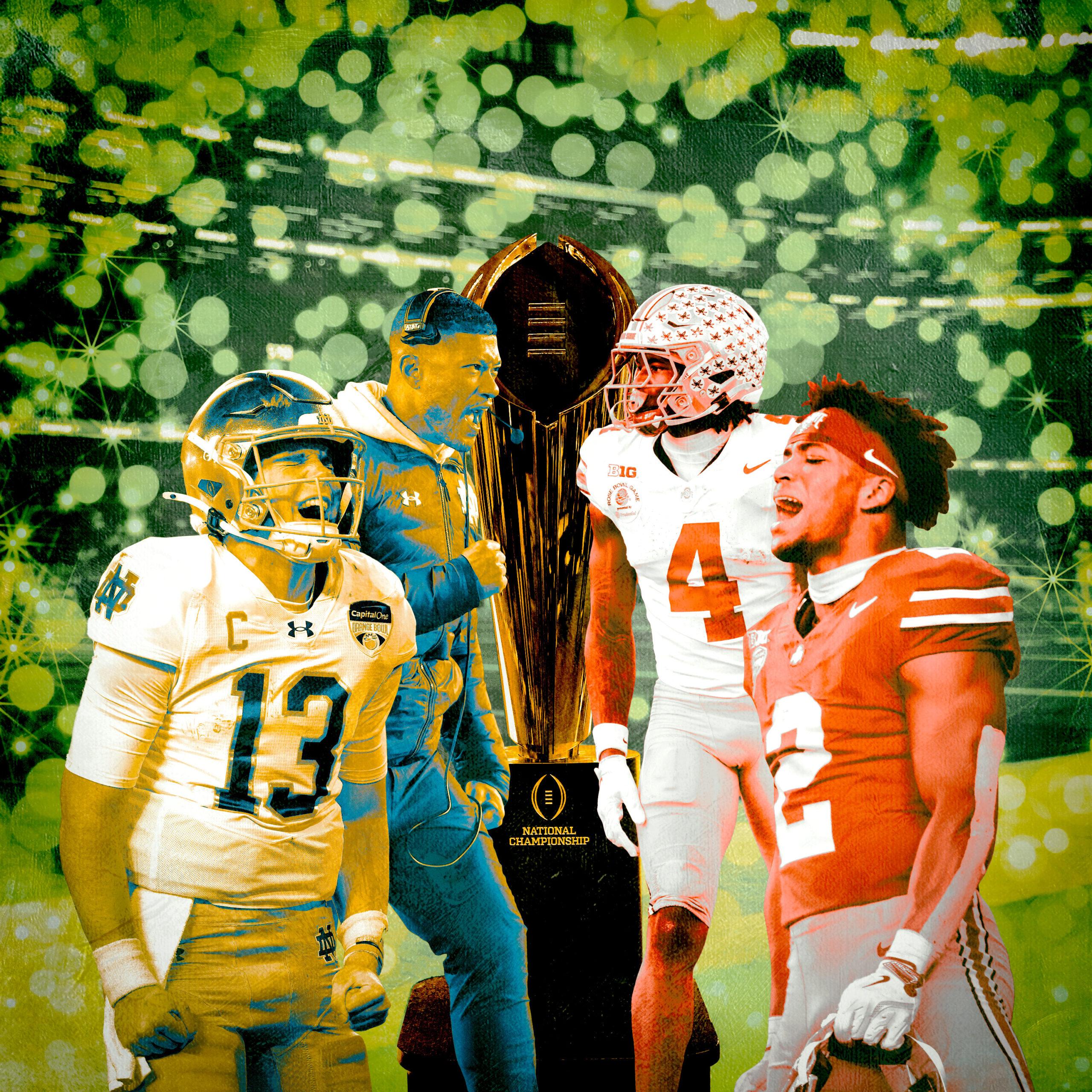In November 2021, a month before Notre Dame’s last flirtation with a College Football Playoff bid, Brian Kelly was already more than a thousand miles away, wearing a purple tie with an LSU pin affixed to his lapel.
The coach’s introductory press conference in Baton Rouge was the culmination of an astonishing series of developments: Kelly had abandoned one of college football’s most storied programs on the precipice of a potential championship run, choosing instead to take over a new-money program that had won three national titles—and played for a fourth—over the past 19 years.
At the podium, Kelly tried to be diplomatic about his reasons for leaving Notre Dame, where he’d won 113 games over 12 seasons and even advanced to the 2013 BCS national championship game. But the subtext was clear: Kelly, the first coach in more than a century to leave Notre Dame for another job, was looking for an upgrade.
“I came down here because I wanted to be with the best,” Kelly told the assembled LSU media corps upon his arrival. “Listen, you’re looked at in terms of championships here. I want that. I want to be under the bright lights. I want to be on the Broadway stage.”
His implication was that Notre Dame, the program that’s tied for fourth all time in college football victories and has claimed 11 national championships, no longer belonged on that marquee. That despite its powerful brand, its unique status as a conference independent, and its lucrative TV deal with NBC, Notre Dame was now a football team whose best days came before the fathers of the nation’s best recruits were born. Do the kids even know who “Rocket” Raghib Ismail is anymore?
There was mounting evidence to support Kelly’s rationale: His 1-7 record against teams ranked in the top five of the AP poll suggested a widening talent gap between Notre Dame and programs like Clemson and Ohio State. His recruiting classes regularly ranked outside the top 10, according to most services, well behind the likes of not only Georgia, Texas, and Alabama but also Texas A&M, Auburn, and Tennessee. And Notre Dame’s most recent playoff game, a 2020 CFP semifinal matchup against Bama, ended in a 31-14 loss that felt much more lopsided than the final score indicated. In his postgame press conference, Kelly bristled at questions about the margins of Notre Dame’s losses in major bowl games.
“This wasn’t a matter of not getting knocked off the ball or not having enough players to compete against Alabama,” Kelly said at the time. “I don’t have a unique problem at Notre Dame. Look at the scores everybody had against Alabama and Clemson.”
A year later, Kelly was gone after an 11-1 season in which the Irish’s lone loss came against the only top-10 team on their schedule (Cincinnati, which later claimed the fourth—and final—playoff seed over Notre Dame). And a little over three years after that, the debate about the Irish’s standing in the college football universe has taken another turn: Notre Dame returns to the national championship game on Monday night for the first time since 2013, facing 8.5-point favorite Ohio State in Atlanta.
The Irish have shown renewed doggedness under Kelly’s successor, Marcus Freeman; they’re 3-2 against AP top-five teams since he took over and in the last month beat the CFP committee’s eighth- (Indiana), second- (Georgia), and fourth-ranked (Penn State) teams to advance to the title game. There’s no denying that they’ve climbed their way back near the peak of the sport.
“Those are the expectations, to be at the mountaintop,” Freeman said at CFP media day on Sunday. “I think there’s not a tremendous amount of programs that can truly say that every year. … Obviously, Ohio State has achieved that goal in more recent years than we have.”
And until Notre Dame ends the longest national championship drought in its history—36 years and counting—doubts about the program’s ability to compete with the best in this new era of college football will remain. Kelly, to be sure, isn’t the only person who has called that into question.
“Some people were like, ‘Why are you going to Notre Dame?’” said running back Jeremiyah Love, holding court at CFP media day. The sophomore grinned as he recalled the quizzical looks and responses he got after choosing Notre Dame over offers from Alabama, LSU, and Michigan, among others.
“They [felt] like there were better schools to go to sports-wise,” Love said, shrugging his broad shoulders.
The chance to win a national championship wasn’t even part of his decision. Asked if he cared whether Notre Dame could seriously compete for a title, Love shook his head. “I’m going to be honest, no. I didn’t really think of that as a factor,” he said. “I just wanted to pick a place that was home, and I just felt this was the right fit.”
That might seem like an unusual answer for a player of Love’s caliber, a four-star prospect from St. Louis who had scholarship offers to play at almost every national power. But it speaks to what Kelly’s frustrations were with Notre Dame’s recruiting pull. While the program has always felt like home to a select group of top players, other factors work against the Irish, from their academic standards to the facilities arms race to, increasingly, geography. South Bend is hundreds of miles from the nation’s top recruiting hotbeds, including Miami, Atlanta, and Dallas. A recruit from one of those areas would have to skip over most of the SEC and Big Ten footprint—both of which continue to expand—to choose a rigorous little private school in northern Indiana. It can be a tough sell.
Of course, Notre Dame’s recruiting roadblocks have been a talking point for generations. School historian Cappy Gagnon traces the conversation back to 1952, when school president Theodore Hesburgh launched a campaign to raise the academic standards. “His goal was not to win championships but to lift Notre Dame from being a football school with a university attached to being a top-flight university,” says Gagnon, a 1966 graduate and former head of the school’s usher program. “By the time I got here 10 years later, our football program was awful. There were folks saying we should play the Ivy League because that’s who we aspired to be academically.”
After the Irish went 19-30 between 1959 and 1963, Notre Dame hired Ara Parseghian as head coach in 1964. At the time, Parseghian was an unorthodox hire for the Catholic university: He was neither an alumnus nor a Catholic, as every coach there had been for nearly half a century. But Parseghian had experience building a competitive team at a university with stringent academic standards, having come from Northwestern. He went 9-1 in his first season at Notre Dame, won a national title in his third, and ultimately joined Knute Rockne and Frank Leahy in the school’s “holy trinity” of football coaches.
“Nothing changed academically, but all of a sudden we’re winning football games again,” Gagnon says. “It proved the woebegone folks were wrong; we actually still can do it.”
Only a couple of Notre Dame coaches have thrived in this setting since Parseghian: Dan Devine and Lou Holtz, both of whom won national championships in their third seasons in South Bend. The rest have mostly failed, from Gerry Faust, who made the jump from a Cincinnati private high school power, to Charlie Weis, a disciple of Bill Belichick. By the time Kelly arrived at Notre Dame in 2010, the Irish’s appeal almost seemed like an anachronism.
“If you’re a top recruit and you go to Southern California, they show you a condo on the beach,” Gagnon says. “If you go to Notre Dame, we show you a room in a dorm that was built 100 years ago.”
Kelly made the most of his opportunity, leading the Irish to the national championship game by his third year, like Parseghian, Holtz, and Devine. But unlike the teams coached by those greats, Kelly’s squad found itself exposed against the sport’s top competition, as Alabama raced out to a 35-0 lead in that year’s title game and coasted to a 42-14 rout to repeat as national champion.
“We’ve got to get physically stronger, continue [to] close the gap there,” Kelly said after the game. “That’s back-to-back national champions. That’s what it looks like. That’s what you measure yourself against there. It’s pretty clear across the board what we have to do.”
Nine seasons later, Kelly was still trying to close that gap before he escaped to Louisiana. Enter Marcus Freeman.
In many ways, Freeman can be seen as a nontraditional hire in the mold of Parseghian. At 35, he was the youngest head coach hired at Notre Dame in nearly 70 years. He had never been a head coach at any level before rising to this job. And he’s the program’s first Asian head coach and only the second Black one. Most notably for the Fighting Irish: He, too, is on the cusp of a national championship in his third year at the helm.
Hiring Freeman was a gamble made only under duress. Notre Dame was rumored to be coveting then–Cincinnati head coach Luke Fickell, but the timing of Kelly’s departure complicated the process. Fickell’s then-undefeated Bearcats were in position to earn the final seed in the four-team playoff, meaning that Notre Dame might have to wait another month—during the most crucial portion of the recruiting and transfer portal calendar—to name its new coach. If Fickell declined the Irish’s offer or chose another one, that meant they would also likely miss out on Freeman, who could have joined Kelly in Baton Rouge.
But Freeman turned out to be exactly who Notre Dame needed. When Notre Dame’s defensive coordinator was elevated to become the head coach, the players’ enthusiastic response went viral. That was the first sign that maybe Notre Dame wasn’t reeling, after all.
Freeman held together the Irish’s highly touted 2021 recruiting class and eventually built on it with more time and experience in the role. A telegenic, deliberate man, Freeman has been praised for his connection to the locker room, his agility on the recruiting trail and in the transfer portal, and his poise and polish in front of the media and boosters.
“He’s just a players’ coach. Everywhere he goes, he’s kind of like one of us,” quarterback Riley Leonard said of Freeman at CFP media day. “You’ll see him today, he’s just wearing a jumpsuit, chilling with the boys, hanging out for media day. Then he knows how to flip the switch, and he has our respect, too. It’s not like he’s one of our teammates.”
All-American safety Xavier Watts, who played for Kelly in his first two seasons at Notre Dame, saw a clear difference once Freeman got the top job: “He maybe relates a little bit more with players.”
Notre Dame was also well positioned to capitalize on the rapidly changing model of college sports. Three months after Freeman was hired, former Irish quarterback Brady Quinn helped launch an NIL collective that generated $20.5 million in revenue in 2023. “Its 2023 earnings nearly doubled those of the University of Texas-dedicated Texas One Fund, and far outstripped the haul brought in by BPS Foundation, the nonprofit serving multiple schools’ collectives run by Blueprint Sports,” reported Sportico. And while Notre Dame has not disclosed its 2024 NIL total—as a private university, it is not required to publicly share financial details—it seems likely that its fund is on par with, or possibly greater than, the $20.3 million fund that Ohio State had in NIL payments this season.
“Notre Dame is willing to play that game at that level,” says Ivan Maisel, a longtime college sportswriter who is working on a book about former Notre Dame head coach Frank Leahy. “Marcus Freeman is there at the time the rules changed, and he’s been able to take advantage of it.”
Add in the expanded 12-team playoff era, and Notre Dame has a whole new outlook. In previous seasons, the fifth-ranked Irish would have missed out on a berth in the playoff field altogether.
Instead, Notre Dame hosted the first home playoff game last month. The scene from South Bend was electric, with green-and-gold-clad fans wrapped in coats, scarves, and beanies, whooping it up in the snow and sub-20-degree wind chill. “I’ve never been a part of an environment like that,” Freeman said after a 27-17 win over Indiana in their first-round matchup. “Not many times in life you’re the first to do something.”
It hasn’t all been smooth. In his first season, Freeman and Notre Dame lost to Marshall and the worst Stanford team in 16 years. And earlier this fall, the Irish suffered the worst defeat any title-contending team has ever taken: a 16-14 loss to Northern Illinois, which finished tied for sixth place in the MAC.
“He’s had some missteps, but he’s still moving forward,” Maisel says of Freeman. “He’s a young, energetic, very smart coach who has shown he is mastering a huge learning curve without getting eaten alive by it. Nobody could have foreseen that.”
Yet the doubts about Notre Dame’s top-end potential still remain.
Consider Ohio State running back Quinshon Judkins, a former three-star recruit from Alabama who signed with Ole Miss out of high school. He took an official recruiting visit to Notre Dame in the fall of 2021, Kelly’s last season with the program, but decided to pass. “I think it was a little far from home for me,” he said at CFP media day.
Two years later, when Judkins was one of the most coveted players in the transfer portal, he didn’t even consider Notre Dame. “In the portal, I was considering a national championship contender,” Judkins said. “I mean, when you go in the portal, you’re trying to win a national championship. That’s why I came to Ohio State.”
But if Freeman and Notre Dame can take down heavily favored Ohio State on the game’s biggest stage, they’ll do more than just end the longest national championship drought in program history. They will change the Irish’s standing in a much more impactful sense: Notre Dame won’t just be a former power with a hallowed history, but a current one.
